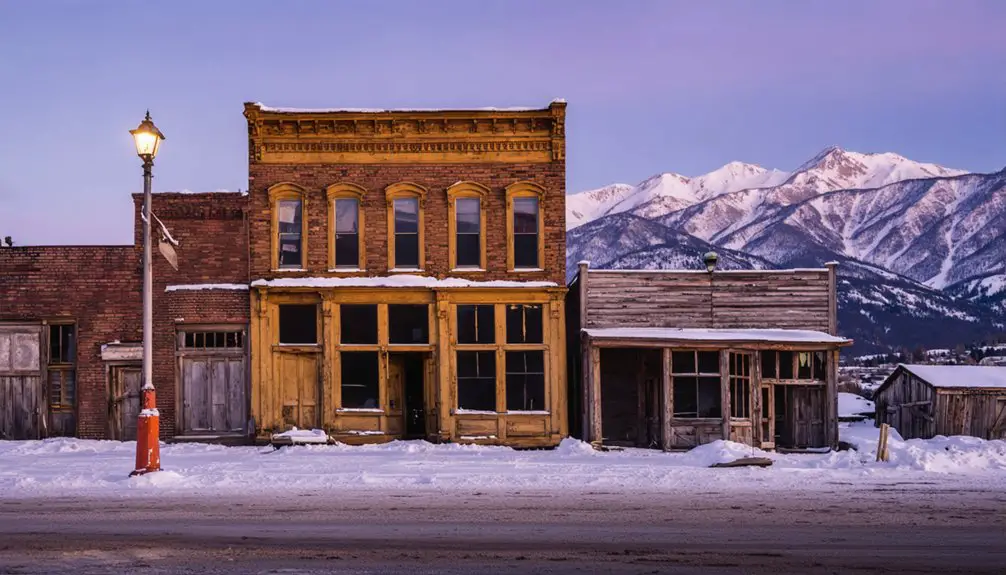You’ll find Park City’s ghost town era emerged from its dramatic fall from a thriving silver mining hub of 10,000 residents in the late 1800s. After the 1893 silver crisis, mine closures, and the Great Depression, the population plummeted to just a few hundred by the 1950s. The once-bustling streets emptied, businesses shuttered, and mines fell silent. While classified as a Type 6 ghost town by Varney, Park City’s story didn’t end in abandonment.
Key Takeaways
- Park City became a ghost town in the 1950s when its population dropped from 10,000 to just hundreds following mining industry collapse.
- Classified as a Class 7 mining ghost town by Stephen Carr in 1972, despite maintaining a small permanent population.
- The 1893 silver crisis, labor conflicts, and Great Depression contributed to Park City’s transformation into a near-ghost town.
- Abandoned mines, shuttered businesses, and vacant buildings characterized the town during its ghost town era of the 1960s.
- The community survived through alternative income sources like bootlegging until ski tourism revitalized the economy.
The Discovery of Silver and Early Settlement Years
When prospectors first discovered silver in Park City during late 1868, they were part of military expeditions traversing the mountains from Big Cottonwood Canyon. A silver outcropping marked during a snowstorm became the future site of the Flagstaff Mine, the region’s first ore-shipping operation.
As you explore this history, you’ll find that Colonel Patrick E. Connor‘s strategic deployment of soldiers for prospecting helped establish the area’s mining potential.
The settlement, initially called Parley’s Park City, quickly attracted laid-off workers from the Transcontinental Railroad, including Chinese laborers. By 1870, you’d have found a growing community of 164 residents. The arrival of the spur line in 1880 significantly improved access to the mining operations.
After the Transcontinental Railroad’s completion, diverse workers flocked to Parley’s Park City, building a bustling frontier community.
The discovery of the Ontario Mine in 1872, with its incredibly rich silver ore yielding 400 ounces per ton, transformed the camp into a premier mining destination. The Ontario Mine went on to become one of the most profitable operations in the district, producing an impressive fifty million dollars in ore throughout its lifetime.
Mining Boom and Population Growth
You’ll find Park City’s incredible transformation began with the Ontario Mine’s silver discovery in 1872, which drew George Hearst’s substantial investment and sparked rapid development.
By 1903, over 80 major mine openings dotted the landscape, while the population swelled from just 164 residents in 1870 to thousands of workers and their families. The arrival of the transcontinental railroad in 1869 proved vital for transporting ore and supplies to support the growing mining operations.
The town’s meteoric rise came from producing staggering quantities of precious metals – including 253 million ounces of silver and 1.45 million ounces of gold between 1875 and 1982 – making it one of the West’s richest mining communities. The Silver King Coalition became one of the area’s most prosperous operations, contributing significantly to local wealth creation.
Silver Discovery Sparks Growth
The discovery of silver near present-day Park City in 1868 ignited a transformative mining boom that would shape Utah’s economic landscape for generations.
You’ll find that soldiers from Fort Douglas made the initial discovery, leading to the first mining claims like the Young American lode in 1869 and the productive Flagstaff Mine.
The economic impact intensified when George Hearst and his partners acquired the Ontario Mine in 1872, revealing an incredibly rich silver vein.
Their mining methods and strategic development transformed the operation into one of the world’s most profitable silver producers.
As word spread, prospectors flooded the area, establishing mining camps that quickly evolved into a bustling settlement.
The forty percent population growth between 1870 and 1900 reflected the area’s rapid development and economic promise.
A devastating major fire in 1898 destroyed 200 structures and left 500 residents homeless, yet the resilient mining community rebuilt and persevered.
The subsequent discovery of gold, lead, zinc, and copper deposits further cemented Park City’s position as a thriving mining powerhouse.
Population Explodes After 1870
Following George Hearst’s lucrative silver discoveries, Park City experienced an unprecedented population surge that reshaped its demographic landscape.
You’d have witnessed the town’s explosive growth from fewer than 200 residents in 1870 to roughly 3,000 by decade’s end. The population demographics shifted dramatically as immigrants from China, Great Britain, Scandinavia, and Eastern Europe flocked to the bustling mining town.
The 1880s brought even greater community diversity as prospectors sent for their families, establishing permanent roots. More than 300 working men occupied the many boardinghouses near the Silver King Mine.
Catholic mine workers and their relatives built churches and meeting halls, while Chinese immigrants formed their own district along Silver Creek. The town’s mining legacy lived on until the silver mining decline of the 1950s forced an economic transformation.
Rich Mining Town Emerges
As silver, gold, and lead deposits emerged from Park City’s mountains in the 1860s, a remarkable mining boom transformed the region into one of America’s richest mineral districts. The Ontario Mine and Silver King Mine led the charge, introducing advanced mining technology that helped extract massive mineral wealth from the earth. By 1903, the area contained over 80 mine openings.
You’d have witnessed a vibrant town spring up as prospectors and their families flooded in, bringing cultural diversity that shaped Park City’s character. Immigrants from China, Britain, Scandinavia, and Eastern Europe built churches, meeting halls, and communities.
Cultural Life in a Thriving Mining Town
During Park City’s mining heyday between 1870 and 1900, a rich tapestry of cultural life emerged as the population swelled to over 10,000 residents.
The town’s cultural diversity flourished as Chinese, British, Scandinavian, and Eastern European immigrants brought their traditions, establishing churches and meeting halls to preserve their heritage. The discovery of silver and gold in the 1860s attracted these diverse groups of settlers to the area.
You’ll find the social scene was vibrant and diverse, reflecting the town’s frontier spirit:
- Saloons and theaters served as primary entertainment venues where miners gathered after long workdays.
- Religious institutions like St. Mary’s School provided education and community support.
- Immigrant groups celebrated their cultures through festivals and gatherings.
- A railroad connection to Salt Lake City by 1880 brought new entertainment options and cultural exchanges.
The mix of entertainment venues, ethnic celebrations, and religious institutions created a dynamic social atmosphere that defined Park City’s character.
The Great Fire of 1898 and Other Disasters
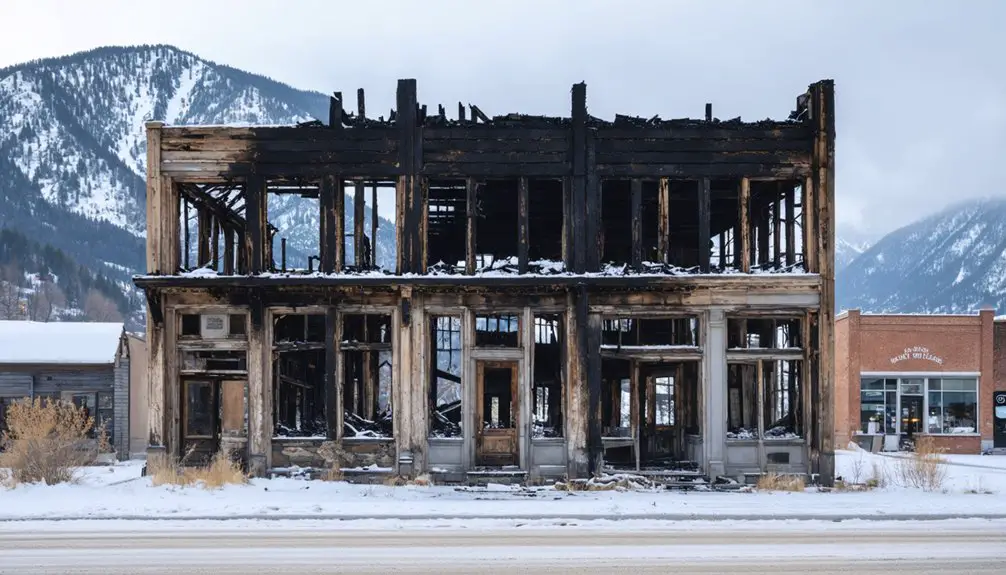
While Park City had already endured fires in 1882 and 1885, nothing could prepare the bustling mining town for the devastating Great Fire of 1898. At 4 a.m. on June 19, strong east winds swept flames from the American House Hotel through Main Street’s wooden structures, destroying about 200 buildings and causing over $1 million in damage.
You would’ve witnessed incredible community resilience as Sheriff Walden alerted the town with gunshots and residents rushed to fight the flames.
Though the fire ravaged the commercial district, including the Grand Opera House and City Hall, Park City’s 8,000-plus residents immediately began rebuilding.
They’d learned their lesson about fire safety, replacing wooden structures with brick and stone buildings.
Despite this disaster and the 1893 silver crisis, the determined community had fully rebuilt by the 1920s.
Economic Decline and Population Exodus
The early 20th century marked a devastating turn for Park City’s once-thriving mining economy. As silver prices plummeted, you’d have witnessed the gradual collapse of the mining industry that had built this prosperous mountain town.
Economic hardship intensified with labor conflicts, including the IWW-led strike of 1919, while the Great Depression delivered another crushing blow to the community.
Here’s what led to Park City becoming a ghost town:
- Falling silver prices forced mine closures, despite Park Consolidated Mining Company’s merger attempts.
- Labor conflicts and strikes after WWI disrupted mining operations.
- The Great Depression crippled remaining mining operations and local businesses.
- Population plunged from 10,000 to just a few hundred by the 1950s.
You wouldn’t see Park City’s revival until the 1960s, when tourism breathed new life into the struggling town.
Transportation Challenges and Isolation
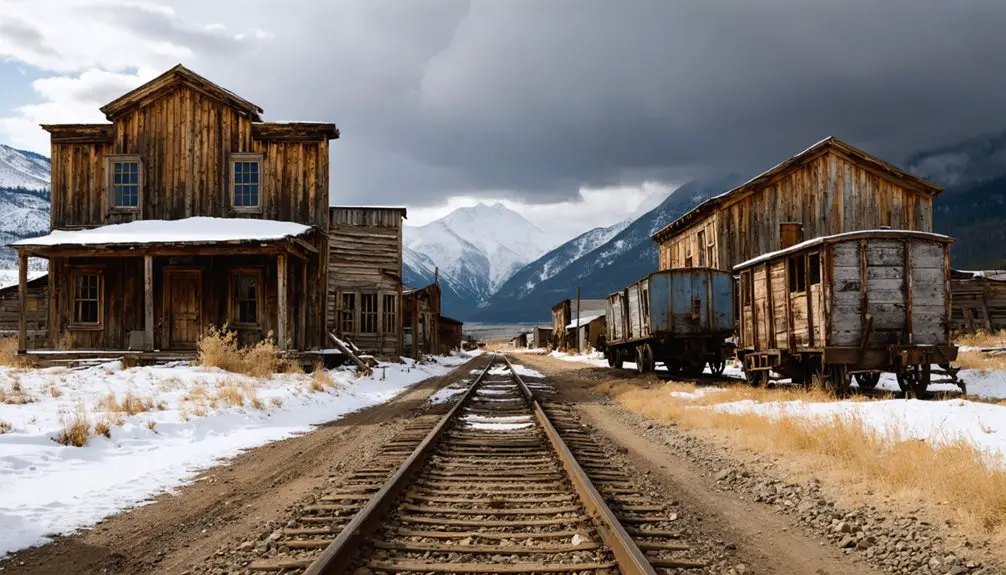
You’ll find that Park City’s transportation woes intensified when both the Denver & Rio Grande Western Railroad and Union Pacific Railroad gradually abandoned their services by the 1950s, leaving the mountain community increasingly cut off.
The challenging terrain of Parley’s Canyon, coupled with inadequate road maintenance, made highway access treacherous and unreliable for the dwindling population.
With just one fire truck, police car, snowplow, and school bus remaining by the ghost town years, Park City’s isolation became a stark reality that compounded its economic struggles.
Railroad Service Ends
As mining operations dwindled in Park City by the mid-20th century, railroad service faced a series of crucial setbacks that would ultimately lead to its complete demise.
You’ll find that Park City’s railroad legacy experienced a dramatic transportation evolution, marked by these major changes:
- DR&G abandoned its Parley’s Canyon line in 1947, cutting off direct rail access to Salt Lake City after nearly six decades of service.
- The closure of coal mines in Grass Creek Canyon by 1887 led to the removal of a crucial 4-mile branch line.
- Union Pacific’s last significant traffic source, phosphate mining, ended abruptly in 1986.
- Following the end of rail service, crews dismantled or paved over the remaining railroad infrastructure, erasing the physical remnants of Park City’s rail network.
Highway Access Lost
Following the abandonment of rail service, Park City’s transportation woes intensified through deteriorating highway access in the 1950s.
You’d have struggled with the limited highway infrastructure, especially in Parley’s Canyon, where steep grades made travel treacherous for trucks and buses. The state focused improvements on the Salt Lake to Park City route while neglecting other essential connections.
Without reliable transportation options, you’d have witnessed the town’s growing economic isolation. Local businesses, including the 50-year-old Welsh, Driscoll and Buck’s department store, shuttered their doors as customer traffic dwindled.
The population plummeted from 7,000 to just 1,366 by the late 1950s. Harsh winter weather and challenging terrain only compounded these difficulties, making highway travel unpredictable and sometimes impossible throughout the year.
Remote Mountain Settlement
When early settlers first encountered Park City’s rugged terrain in the mid-1800s, they faced intimidating geographical barriers that shaped the town’s development.
You’d find yourself hemmed in by towering mountains on three sides, with limited mountain access through primitive wagon trails and Parley Pratt’s costly toll road. The harsh alpine environment made year-round transportation nearly impossible.
- Pack animals struggled along treacherous mountain paths to transport essential supplies and mining equipment.
- Brutal winters forced residents to stockpile goods, as snow and avalanches routinely cut off access.
- Spring thaws created hazardous mudslides that damaged the few existing roads.
- Rail arrival in the late 1800s finally conquered the rugged terrain, enabling large-scale mining operations and growing the population to 10,000.
Daily Life During the Ghost Town Era
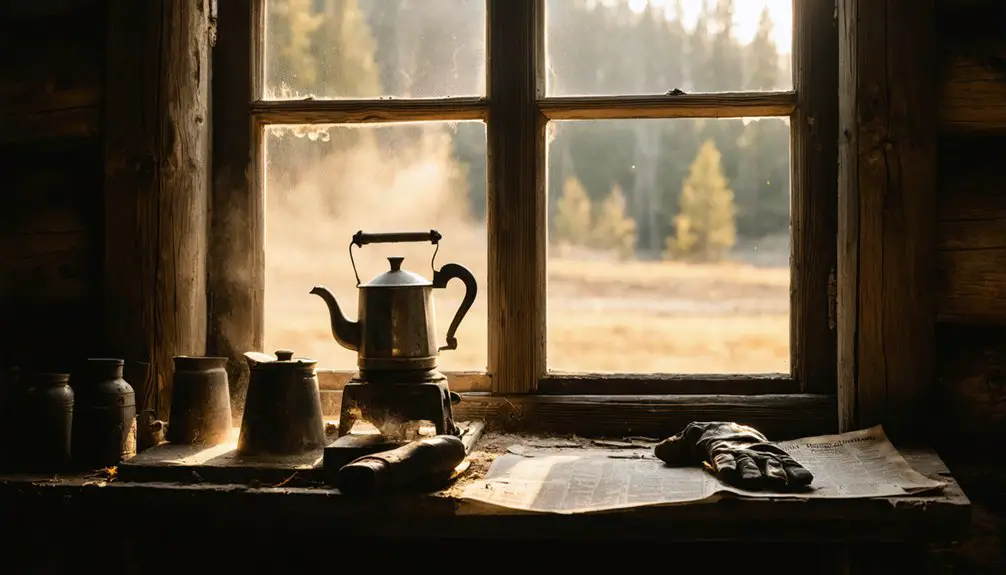
The dramatic decline of Park City’s silver mining industry transformed daily life into a struggle for survival during the ghost town era.
You’d have witnessed the population plummet from 7,000 to just 1,366 by 1960, as mine closures eliminated 1,200 jobs. Community resilience emerged through alternative income sources, including an illicit economy of bootlegging and red light district activities.
Your daily experience would’ve included maneuvering through abandoned buildings and shuttered businesses, while The Park Record newspaper remained a constant thread of community connection.
You’d have seen long-standing department stores close their doors as neighbors moved away. Those who stayed adapted by exploring early tourism opportunities, including a pioneering ski lift system that would eventually transform the town’s identity from mining outpost to winter recreation destination.
Classification in Ghost Town Guides
Ghost town classification systems emerged in the 1970s to help historians and tourists understand the complex nature of abandoned or declining settlements.
When you’re exploring Park City’s historical significance, you’ll find it’s classified under several key systems that reveal its unique status as a living ghost town.
- Stephen Carr’s 1972 system labeled Park City as a Class 7 mining ghost town, indicating many original structures remained intact.
- Under Varney’s classification, Park City fits Type 6, featuring numerous historic buildings with an active population.
- The town’s mining heritage places it in a special category of ghost towns defined by boom-and-bust cycles.
- Despite maintaining residents, Park City earned its ghost town classification through significant population decline and preserved historic structures, challenging traditional abandonment criteria.
From Mining Ghost Town to Resort Destination
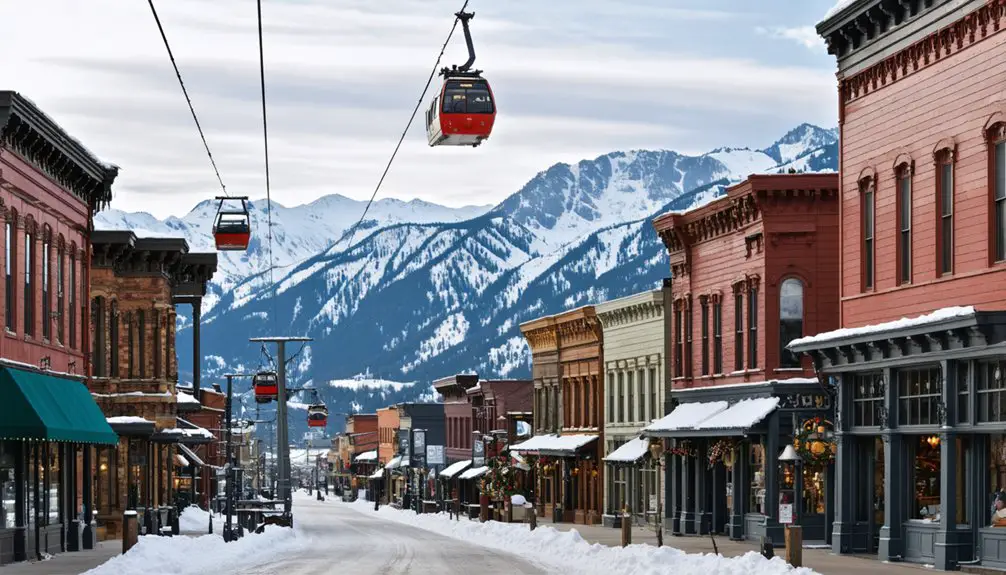
Discovering silver in 1868 transformed Park City from an unremarkable mountain settlement into one of America’s wealthiest mining boomtowns.
You’d have found a thriving community of over 10,000 people during the peak silver mining era, with the Ontario Mine leading production.
Frequently Asked Questions
Were There Any Documented Paranormal Activities During Park City’s Ghost Town Years?
Mournful miners mysteriously materialized during documented paranormal sightings and ghostly encounters. You’ll find accounts of the Yellow Slicker Man, Freddy Hagland’s spirit, and Hope Daisy’s ghost haunting historic buildings.
What Happened to the Original Mining Equipment and Infrastructure After Abandonment?
You’ll find most mining structures were torn down by owners, though some restoration efforts saved key pieces like the Silver King Tramway towers. Historical preservation transformed others into modern amenities like ski lodges.
How Did Remaining Residents Get Basic Supplies During Isolation?
You’d rely on pooled resources and shared transport to navigate limited supply routes, bartering locally, growing food at home, and coordinating bulk deliveries to overcome isolation challenges through informal community networks.
Did Any Famous Outlaws or Notorious Criminals Hide in Park City?
While outlaw legends suggest criminal hideouts existed nearby, you won’t find direct evidence of Butch Cassidy or other famous outlaws specifically hiding in town – they preferred remote spots like Robbers Roost.
What Was the Average Home Price During Park City’s Ghost Town Period?
You won’t find exact average property values from the 1950s ghost town period, but historical housing trends suggest homes were heavily devalued, abandoned, or sold far below pre-mining crash prices.
References
- https://www.parkrecord.com/2025/02/12/way-we-were-falling-off-the-map/
- https://www.parkcitymag.com/arts-and-culture/2018/12/how-park-city-survived-the-ghost-town-years-of-the-1950s
- https://parkcitylibrary.org/utah-ghost-towns/
- https://historytogo.utah.gov/history-park-city/
- https://journal.alpsandmeters.com/journal/2024/10/3/jnawx6hhrucatizzouq7346kcfy8x6
- https://www.uen.org/utah_history_encyclopedia/p/PARK_CITY.shtml
- https://www.visitparkcity.com/things-to-do/museums-history/park-city-mining-boom/
- https://parkcity.gov/about-us
- https://parkcityhistory.org/park-city-historic-timeline/
- https://ushpo.utah.gov/repository-item/historic-mining-resources-of-park-city-utah-multiple-property-submission/
